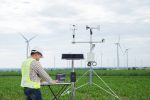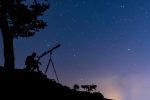| Storm Chaser Key Stats | |
|---|---|
| Avg. Salary / year | $103,980 |
| Avg. Pay / hour | $49.99 |
| Education | 3-4 Years |
| Job Outlook | 8% |
| Total Employed | 8,780 |
A storm chaser is a meteorological researcher who works on the field, very much in the center of all the action.
When you become a storm chaser, you will travel the country looking for storms, and reporting their activity to weather authorities.
The information gathered by storm chasers helps weather bureaus to give accurate forecasts and warnings.
Storm chasers also conduct research to improve future storm detection and weather forecasting.
There are many storm chasers out there that do this work as a hobby and do not get paid for their findings.
Others are paid scientists and researchers who complete field work and will later compile reports and publish their research.
Storm chasing has become popular, so much so that you can actually go on a tour to learn about how this process works.
Go to Page Section:
Education Requirements to Become a Storm Chaser
If you want to become a storm chaser for a hobby, get in contact with the national weather service to find out about a short course called SkyWarn.
This will teach you the basics of storm watching, such as how to predict storm activity, how to measure statistics, and also how to keep yourself safe.
Learning how to use a radio is also important.
If you want to work as a storm chaser for your profession, it’s important to note that most people in this vocation don’t make a lot of money.
Some people do become a storm chaser full time, they sell date, photos, and video recordings to media agencies to make their income.
They have to invest a lot of what they make into travel, equipment, and legal costs.
If there are no storms, they don’t make any money.
The average salary for this kind of storm chaser is $18,000 a year.
Many storm chasers will support themselves with a second job, or will only work as a storm chaser seasonally.
Other storm chasers are actually meteorologists who chase storms as a part of a research project, or as a part of a larger job description.
For instance, they may teach at a college, or work for the weather service, and spend a few months a year chasing storms and collecting data.
To become a meteorologist, you will need to complete a four year bachelor’s degree in science, followed by a postgraduate degree in meteorology.
Storm Chaser Job Description
When you become a storm chaser, you will be hunting down severe weather patterns.
Usually, you will start with a report that severe conditions are expected in a particular area.
Most often with a team and specialized equipment, you’ll head out to the site and try and reach the storm.
This involves predicting its behavior and direction.
At the site of the storm, there are many things a storm chaser might do.
They may set up meteorological equipment to take various readings and data.
They might take video and photographs of the storm.
They will usually report to authorities via radio the severity and direction of the storm from the ground, so as any due warnings can be given.
Here are some of the duties of a storm chaser:
- Monitoring weather forecasts
- Locating and following storms
- Setting up meteorological testing equipment
- Collecting data
- Analyzing data and writing reports
- Writing articles
- Taking photography and video of storms
- Selling photography and video to media agencies
Storm Chaser Salary and Career Path
How you become a storm chaser will determine your career path.
For instance, a hobbyist will often start out work as an assistant to a researcher or experienced storm chaser.
Many hobbyists have other jobs, and only spend a few months of the year chasing storms.
A meteorologist will spend much time at college and completing research before they enter the field.
They may work for the National Weather Service, a college, or a private weather firm.
Like hobbyists, they will only spend a small fraction of their time actually on the field, and will likely have many other research projects on the go at the same time.
A storm chaser makes a median salary of $18,000 a year, mostly from selling data, video, and photography they take.
However a meteorologist makes far more than this, and are usually paid a salary by an employer.
There are many similar roles that you might move on to as a storm chaser, or complete in conjunction with this job:
- Meteorologist
- Geologist
- Photographer
- Videographer
- Scientific Researcher
If you’re looking for a very exciting job that will get your adrenaline pumping, then you might like to become a storm chaser.
There are not many paid opportunities in this field, and most are self-employed, so it is definitely an area you want to get into for the love of the chase, and not for the compensation.
![]() The below information is based on the 2024 BLS national averages.
The below information is based on the 2024 BLS national averages.
National Average Salary
$103,980Average Salary by State
| State | Avg. Annual Salary |
|---|---|
| Alabama | $87,450 |
| Alaska | $104,660 |
| Arizona | $95,590 |
| Arkansas | $99,730 |
| California | $121,620 |
| Delaware | - NA - |
| District of Columbia | $139,730 |
| Florida | $99,160 |
| Georgia | $97,060 |
| Hawaii | $120,620 |
| Idaho | $111,770 |
| Illinois | - NA - |
| Indiana | $132,370 |
| Iowa | $81,210 |
| Kansas | $82,970 |
| Kentucky | $77,110 |
| Louisiana | $105,980 |
| Maine | $104,360 |
| Maryland | $118,890 |
| Massachusetts | - NA - |
| Michigan | $101,700 |
| Minnesota | - NA - |
| Mississippi | $77,670 |
| Missouri | $113,740 |
| Montana | $103,370 |
| Nebraska | $103,260 |
| Nevada | $115,560 |
| New Hampshire | $67,400 |
| New Jersey | $118,520 |
| New Mexico | $109,840 |
| New York | $131,440 |
| North Carolina | $108,690 |
| North Dakota | $90,360 |
| Ohio | $91,560 |
| Oklahoma | $91,200 |
| Oregon | $124,830 |
| Pennsylvania | $91,970 |
| South Carolina | $98,460 |
| South Dakota | $92,300 |
| Tennessee | $109,970 |
| Texas | $92,860 |
| Utah | $71,250 |
| Virginia | $124,270 |
| Washington | $104,290 |
| West Virginia | $70,020 |
| Wisconsin | $105,040 |
| Wyoming | $88,120 |
| Puerto Rico | $74,630 |
The highest-paying state in this field is District of Columbia, with an average salary of $139,730.
Here are the five states with the highest salaries in the field:
* Employment conditions in your area may vary.
Frequently Asked Questions
What does a storm chaser do?
Storm chasers predict weather conditions and get close to storms.
The main aims of these specialists might differ; some chase storms for news coverage or scientific examination, while others document their experiences and even offer tours.
In most cases, a storm chaser is a meteorologist who studies and predicts weather patterns.
The typical duties of storm chasers usually include forecasting where and when a storm will occur; analyzing past and current data; looking at the patterns of the clouds; capturing storms on film; documenting the experience on paper; publishing forecasts, and so on.
A storm chaser uses a wide range of special equipment – satellites, computers, anemometers, GPS, portable weather stations, etc.
How much do storm chasers make?
The storm-chasing season in the United States is very short, usually from April to June.
That’s why the average salary of a storm chaser is not very high.
In Kansas, for example, a specialist can earn $16.000.
You can get paid around $500 for storm footage.
In case you decide to offer storm chasing tours, you can make about $3.500 on one mission (however, the expenses are also high).
There are cases when storm chasers made a career on TV; Reed Timmer and his show are worth $250.000.
How much does it cost to become a storm chaser?
There are no specific educational requirements for becoming a storm chaser; however, a relevant degree would certainly be helpful.
You might want to obtain a bachelor’s degree in meteorology or atmospheric science, for example.
A year in a university can cost you anywhere between $8.000 and $45.000 (and more); the cost depends on a variety of factors (the books, supplies, and accommodation expenses are not included).
If you decide to offer storm chasing tours, you would have to provide accommodation and transportation.
You would need to splurge on camera equipment, in case you want to document storms (lenses, tripods, actual cameras, and so on).
You are also advised to take a CPR class (around $30), as there is an ever-present danger of being struck by lightning.
What is the demand for storm chasers?
Between 2018 and 2028, the atmospheric scientist (including meteorologists and storm chasers) job market is expected to grow by 8%, according to the Bureau of Labor Statistics.
That is a little faster than the national average for all occupations in the United States.
Violent weather occurrences are becoming more frequent nowadays; that’s why there will be more job opportunities for storm chasers.
In case you have a relevant degree, you will be able to find a similar job during the months when there are not that many storms across the country.
How long does it take to become a storm chaser?
It will take you 4 years to obtain a bachelor’s degree in meteorology, in case you decide to go for one.
A CPR class, in most cases, lasts for 2.5-3 hours.
Finding an internship in the industry and getting that on-the-job experience will be extremely helpful for your future career.
The last half of May is usually the best time for storm chasers.
There is also a small window of severe weather in late September or early October in Tornado Alley.













